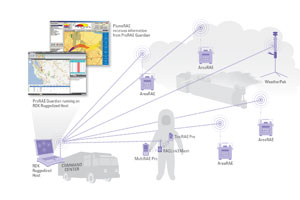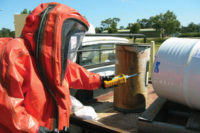
|
|
A wireless network of area gas detectors, personal gas detectors and a weather monitor can be monitored at a mobile command center equipped with plume-tracking software and other software applications. |
These incidents often release hazardous and toxic materials that put plant workers, first responders and members of the public in nearby communities at risk for short-term and long-term injuries and illnesses. In some cases, they may even cause deaths. The laundry list of toxic gasses includes hydrogen sulfide (H2S), sulfur dioxide (SO2), and volatile organic compounds, such as benzene, toluene and xylenes.
Installing a gas-detection system is one way to improve refinery and chemical-plant safety and reduce the risk of catastrophic incidents. Traditional, hard-wired systems can, however, be quite expensive. Wireless gas monitoring systems, on the other hand, are very cost-effective and help incident and safety managers avoid safety incidents and mitigate the problems they cause if they should occur.
Wireless is flexible and cost-effective
Installation is simply a matter of moving a wireless detector to the desired location so wireless monitors can be repurposed for uses where toxic-gas monitoring is needed most. The ability to quickly and easily swap wireless gas monitors also results in faster maintenance; in a fixed system, a damaged sensor or a damaged cable can shut down a process for hours, where with a wireless system, a gas monitor can quickly be swapped out and maintenance performed on the faulty monitor as time permits in the maintenance shop.
A key advantage of a wireless gas-detection system is that it is very cost-effective when compared to hard-wired systems. Installation costs, for example, are much lower for wireless systems than for hard-wired systems. Hard-wired detection systems often cost three to four times more than equivalent wireless systems.
A major component of this cost differential is the high cost of installing cable-based detection systems so that they meet intrinsic-safety requirements. Wireless monitors are available that are certified intrinsically safe right out of the box. Because they operate stand-alone, you don’t have to worry about certifying the intrinsic safety of the installation.
With fixed systems, power requirements can also be a concern. Using a fixed-wire system requires a hard-wired power source, which can be quite costly. A wireless system, on the other hand, can use battery power to bypass the electrical grid and will also continue to operate during catastrophic conditions, such as power failures.
Depending on the type of sensor, battery packs last from six months to a year before requiring replacement or charging. The use of solar panels enables the gas monitor to run continuously year round (and deliver a more “green” solution).
Improved visibility means better safety
Wireless gas-detection systems improve worker safety by helping to prevent accidents. Not only can area monitors be installed in locations where they can detect problems early, workers can be provided with personal monitors that can provide additional data. These sensors can also be equipped with GPS receivers so that a worker’s position is accurately known.
These monitoring devices provide source data, but software converts the data into meaningful information, giving safety managers much greater visibility and control. It’s similar to how GPS navigation software converts raw traffic data on a range of different routes to generate information on which route is the fastest, shortest or cheapest (without toll charges).
In a similar way, gas-detection monitoring software aggregates raw data, instantly converting it to actionable information. Under normal operating conditions, the system helps safety managers keep an eye on toxic gas levels and head off problems. Should an incident occur, the system helps first responders quickly evaluate concentration levels of a toxic plume and determine its travel direction so critical decisions — such as evacuation or shelter-in-place orders — can be made quickly and with assurance.
Wireless gas-detection systems also offer better interoperability than hard-wired systems. Incident and safety managers can view and share toxic gas levels with local fire departments or other first responders, if appropriate, allowing both private and public organizations to work together during hazardous chemical or vapor events.
Advances in secure Internet access and the ability to get data onto the Internet from almost anywhere have made these real-time interactions possible, and have become an operational advantage to globally distributed safety teams as well as multinational firms. One of the advantages is that it allows wireless system users to call in exactly the right industrial hygienist, safety expert or plant manager in the same way that doctors working in remote locations can work with medical-center specialists.
Case studies
These and other features prompted Total Petrochemicals & Refining USA, Inc. to install nearly 50 wireless gas-detection monitors at the tank farm at its Port Arthur (Texas) refinery. The system is the world’s first automated wireless gas-detection system integrating radio frequency-enabled gas-detection monitors with intrinsically safe solar power and plume-modeling software. The system monitors approximately 100 storage tanks, including tanks located several miles away.
The plant’s health supervisor and industrial hygienist, Alan Brown, was skeptical at first about using wireless gas detectors. Now, however, he’s a big fan. Says Brown, “I am a big proponent of wireless technology and the capabilities it brings to providing and enhancing safety in industrial environments.”
Using wireless gas-detection systems, safety-service company TekSolv (www.teksolv.com), has provided cost-efficient solutions to several of its clients, says the company’s Sales and Business Development Manager Michael P. Ryan.
Recently, an oil-and-gas refinery in the U.S. turned to TekSolv (a Newark, DE-based company that provides a full range of cost-effective safety and gas detection services to reduce costs for their clients and to make sure its customers comply with regulations) for a wireless system that deployed as a temporary replacement for an aged and degraded fixed system that monitored the facility’s crude unit. The refinery safety manager liked the wireless approach so much that he subsequently purchased the system, and permanently replaced the fixed-wired system with a fixed-wireless solution that provides real-time data to a control-room computer.
“Swapping out the fixed-wired system would have cost them a lot of money in man-hours to run wires and conduit,” says Ryan. “While wireless solutions have not traditionally been thought of as a permanent, fixed-monitor solution, we are seeing more of our customers go that way.”
It’s a very clean and controlled environment, says Ryan, and cable-free gas detection helps keep it that way. The wireless gas-detection system provides portability that allows them to easily locate the system to the different production areas of the plant where worker-safety threats exist.
“Wireless detection applications today have a proven track record for delivering new functionality and unmatched safety improvements,” says Ryan. “These systems are making an impact by raising safety and reducing the overall cost of detection monitoring.”
Wireless gas-detection enhances safety
- Low cost of ownership and simple installation
- Easy portability for quickly moving from one location to another
- Real-time detection of toxic and hazardous gas and radiation threats
- Integration of multiple monitors viewable on a single screen with map overlays
- Multiple alarms, including at the source and at centralized monitoring locations
- Reduction in exposed cables reduces hazards
- Man-down and biometric alarms alert operators to medical emergencies
Source:
RAE Systems’ book “Wirelessly Networked Chemical & Radiation Detection Systems: Essential Technologies and Applications for Increased Safety in Continuous Gas and Radiation Monitoring.” It’s available at Amazon Books.








